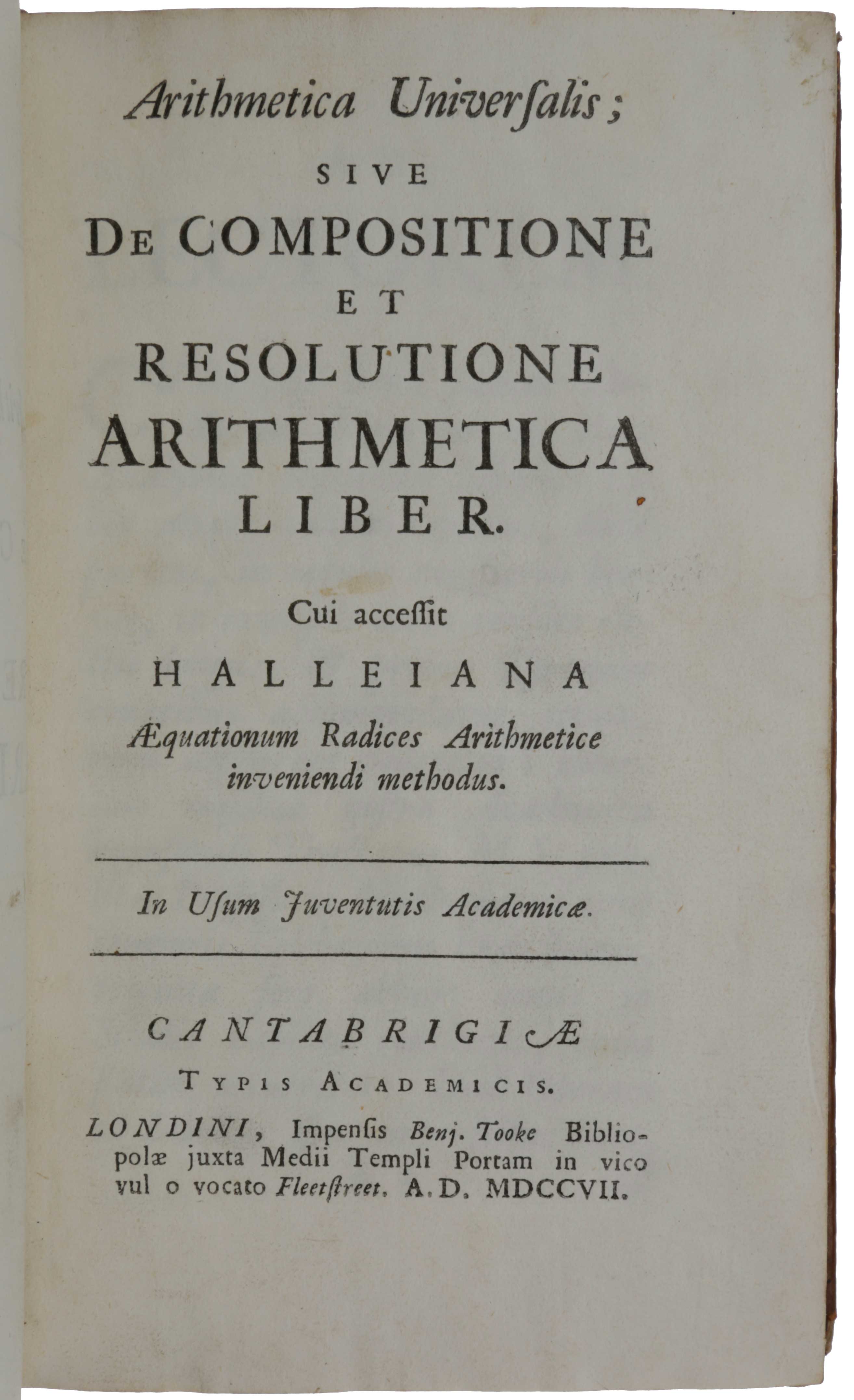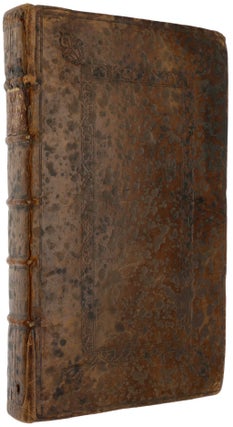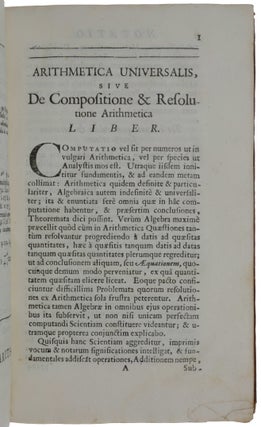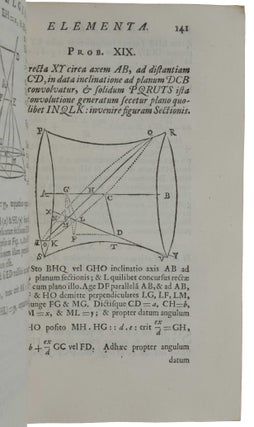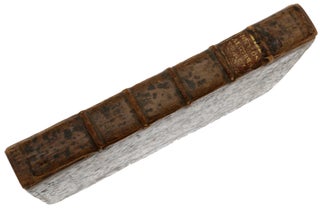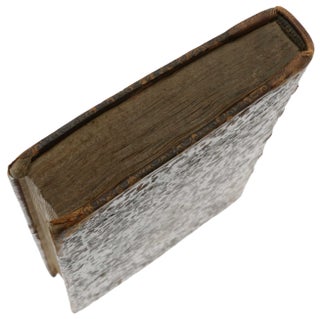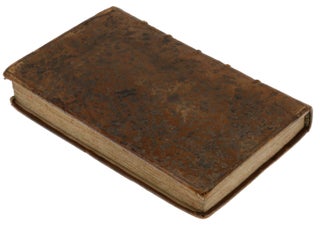Arithmetica Universalis; sive de Compositione et Resolutione Arithmetica Liber. Ciu accessit Helleiana Aequationum Radices Arithmetice Inveniendi Methodus ...
Cambridge; London: Typis Academicus; Benjamin Tooke, 1707. First edition of Newton’s treatise on algebra, or ‘universal arithmetic,’ his “most often read and republished mathematical work” (Whiteside). “Included are ‘Newton’s identities’ providing expressions for the sums of the ith powers of the roots of any polynomial equation, for any integer i [pp. 251-2], plus a rule providing an upper bound for the positive roots of a polynomial, and a generalization, to imaginary roots, of René Descartes’ Rule of Signs [pp. 242-5]” (Parkinson, p. 138). About this last rule for determining the number of imaginary roots of a polynomial (which Newton offered without proof), Gjertsen (p. 35) notes: “Some idea of its originality … can be gathered from the fact that it was not until 1865 that the rule was derived in a rigorous manner by James Sylvester.” Provenance: Jesuit College at Ghent (ink inscription ‘Bibliotheca Collegii Gandavensis Soc[ietatis] Jesu.’ and shelfmark on title); extensive marginal annotations by a well-informed contemporary reader. This reader was possibly the English Jesuit Christopher Maier (1697-1767). Born in Durham, England, Maier entered the Society of Jesus in 1715. He taught at Liège, where he became interested in astronomy. In 1750, Maire was commissioned by Pope Benedict XIV to measure two degrees of the meridian from Rome to Rimini with fellow Jesuit Roger Boscovich, with a view to mapping the Papal States; in turn, they proved that the earth is an oblate spheroid, as Newton had proposed in Principia, publishing their results in Litteraria Expeditione (1755). Maier spent his final years at the English Jesuit College in Ghent. “In fulfillment of his obligations as Lucasian Professor, Newton first lectured on algebra in 1672 and seems to have continued until 1683. Although the manuscript of the lectures in [Cambridge University Library] carries marginal dates from October 1673 to 1683, it should not be assumed that the lectures were ever delivered. There are no contemporary accounts of them and, apart from Cotes who made a transcript of them in 1702, they seem to have been totally ignored. Whiteside (Papers V, p. 5) believes that they were composed ‘over a period of but a few months’ during the winter of 1683-4” (Gjertsen, pp. 33-4). The course of lectures stemmed from a project on which Newton had embarked in the autumn of 1669, thanks to the enthusiasm of John Collins: the revision of Mercator’s Latin translation of Gerard Kinckhuysen’s Dutch textbook on algebra, Algebra ofte stel-konst (1661). Newton composed a manuscript, ‘Observations on Kinckhuysen’, in 1670 (see Whiteside, Papers II) and used it in the preparation of his lectures. He took the opportunity not only to extend Cartesian algebraic methods, but also to restore the geometrical analysis of the ancients, giving his lectures on algebra a strongly geometric flavor. “When Newton resigned his Lucasian professorship to his deputy William Whiston in December 1701, it was natural that the latter should wish to familiarize himself with the deposited lectures of his predecessor” (Whiteside, Papers V, p. 8). Whiston later claimed (in his Memoirs, London: 1749) that Newton gave him his reluctant permission to publish the lectures. Whiston arranged with the London stationer to underwrite the expense of printing the deposited manuscript and then subsequently, between September 1705 and the following June, corrected both specimen and proof sheets as they emerged from the University Press. The completed editio princeps finally appeared in May 1707, priced at 4s. 6d., without Newton’s name on the title page, although references inside the work made no attempt to hide the author’s identity. It included an appended tract by Halley on ‘A new, accurate and easy method for finding the roots of any equations generally, without prior reduction’ (pp. 327-343). Publication of the work had been delayed by Newton, who complained that the titles and headings were not his and that it contained numerous mistakes. Yet when he prepared a second edition in 1722 the changes he introduced were “primarily reorderings of his own manuscript, not corrections of Whiston’s additions” (Westfall, p. 649). In reality, Newton’s misgivings probably derived more from his reluctance to place before the public a relatively immature and poorly organized work, and one that did not take into account the developments in the subject that had taken place in the quarter century since the manuscript was composed. For a book that was to become Newton’s most often republished mathematical work, the Arithmetica initially made little impact in Britain, and was not even graced by a review in the Philosophical Transactions. On the Continent the reception accorded the lectures was more positive. “Leibniz, unhesitatingly divining their author beneath the cloak of anonymity, gave them a long review in the Acta Eruditorum of Leipzig in 1708. Written thirty years before, he noted, and now deservingly printed by William Whiston, he assured the reader that ‘you will find in this little book certain particularities that you will seek in vain in great tomes on analysis.’ His close associate, Johann Bernoulli, despite some adverse remarks paid Newton the compliment in 1728 of basing his own course on the elements of algebra upon Newton’s text. Perhaps partly in consequence of Newton’s recent death, in Britain too the book began about this time to arouse greater interest than when it was first issued in 1707” (Hall, p. 174). Despite the impressive contributions of the work to the theory of equations, mentioned earlier, it is difficult to pigeonhole the work as being either algebraic or geometric. From one point of view, the Arithmetica can be seen as a fulfillment of the programme outlined by Descartes in the Géométrie because it teaches how geometrical problems (and also arithmetical and mechanical ones) can be translated into the language of algebra. Paradoxically, however, Newton criticized Descartes, maintaining that, at least in some cases, Apollonian geometry is to be preferred to Cartesian algebra in the analysis of indeterminate problems. Modern analysts, he complained, had confused algebra and geometry: “The Ancients so assiduously distinguished them one from the other that they never introduced arithmetical terms into geometry… recent people by confusing both, have lost the simplicity in which all elegance in geometry consists” (Whiteside, Papers V, p. 429). The last section of the work ‘The linear construction of equations’ (pp. 279-326), is particularly anti-Cartesian (the term ‘linear’ in this context does not refer to straight lines but derives from Pappus). Newton here deals with the problem of constructing cubics (third-degree equations) that Descartes solved via the intersection of a circle and a parabola. Newton proposed instead to use a curve of degree higher than the conics as a means of construction, namely the conchoid (a fourth-degree curve). Newton regarded the conchoid as preferable because it has a mechanical construction and leads to a more elegant solution of the problem. William Whiston {1667-1752) was “a member of the first generation of Cambridge students to emulate Newton’s method and principles. He went up to Cambridge in 1686, claimed to have attended one or two incomprehensible lectures by Newton on his Principia, and was elected a Fellow of Clare Hall in 1691. After taking orders he left Cambridge for a while, returning in 1700 when chosen by Newton to be his deputy as Lucasian Professor. About a year later, upon Newton’s resignation and commendation, Whiston succeeded him. Aberrant theology was to be his downfall. While Newton and their common friend Dr Samuel Clarke kept private their doubts about Trinitarianism, the Creed and the Thirty-nine Articles, Whiston sought publicly to amend the errors of the Anglican faith; for this he was summoned before the heads of houses in the university and dismissed from his post in 1710” (Hall, p. 175). Babson 199; Wallis 277; D. Gjertsen, Newton Handbook, 1986; A. R. Hall, Isaac Newton, 1992; R. S. Westfall, Never at Rest, 1983.
8vo, pp. [viii], 343. Woodcut diagrams throughout. Former owner’s signature (F. Percy White, Feb. 1920?) on half-title partially erased. Contemporary mottled calf, covers with floral border and corner fleurons in blind.
Item #4639
Price: $25,000.00

